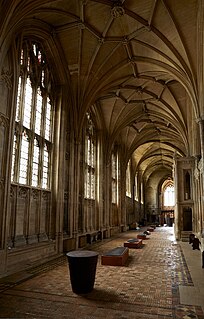Related Research Articles

Studio glass is the modern use of glass as an artistic medium to produce sculptures or three-dimensional artworks. The glass objects created are intended to make a sculptural or decorative statement. Though usage varies, the term is properly restricted to glass made as art in small workshops, typically with the personal involvement of the artist who designed the piece. This is in contrast to art glass, made by craftsmen in factories, and glass art, covering the whole range of glass with artistic interest made throughout history. Both art glass and studio glass originate in the 19th century, and the terms compare with studio pottery and art pottery, but in glass the term "studio glass" is mostly used for work made in the period beginning in the 1960s with a major revival in interest in artistic glassmaking.

Woodturning is the craft of using a wood lathe with hand-held tools to cut a shape that is symmetrical around the axis of rotation. Like the potter's wheel, the wood lathe is a simple mechanism that can generate a variety of forms. The operator is known as a turner, and the skills needed to use the tools were traditionally known as turnery. In pre-industrial England, these skills were sufficiently difficult to be known as 'the misterie' of the turners guild. The skills to use the tools by hand, without a fixed point of contact with the wood, distinguish woodturning and the wood lathe from the machinist's lathe, or metal-working lathe.

The decorative arts are arts or crafts whose object is the design and manufacture of objects that are both beautiful and functional. It includes most of the arts making objects for the interiors of buildings, and interior design, but not usually architecture. Ceramic art, metalwork, furniture, jewellery, fashion, various forms of the textile arts and glassware are major groupings.

Folk art covers all forms of visual art made in the context of folk culture. Definitions vary, but generally the objects have practical utility of some kind, rather than being exclusively decorative. The makers of folk art are typically trained within a popular tradition, rather than in the fine art tradition of the culture. There is often overlap, or contested ground with 'naive art'. "Folk art" is not used in regard to traditional societies where ethnographic art continue to be made.

Visual arts education is the area of learning that is based upon the kind of art that one can see, visual arts—drawing, painting, sculpture, printmaking, and design in jewelry, pottery, weaving, fabrics, etc. and design applied to more practical fields such as commercial graphics and home furnishings. Contemporary topics include photography, video, film, design, and computer art. Art education may focus on students creating art, on learning to criticize or appreciate art, or some combination of the two.

Studio pottery is pottery made by professional and amateur artists or artisans working alone or in small groups, making unique items or short runs. Typically, all stages of manufacture are carried out by the artists themselves. Studio pottery includes functional wares such as tableware and cookware, and non-functional wares such as sculpture, with vases and bowls covering the middle ground, often being used only for display. Studio potters can be referred to as ceramic artists, ceramists, ceramicists or as an artist who uses clay as a medium.

American craft is craft work produced by independent studio artists working with traditional craft materials and processes. Examples include wood, glass, clay (ceramics), textiles, and metal (metalworking). Studio craft works tend to either serve or allude to a functional or utilitarian purpose, although they are just as often handled and exhibited in ways similar to visual art objects.

Art jewelry is one of the names given to jewelry created by studio craftspeople. As the name suggests, art jewelry emphasizes creative expression and design, and is characterized by the use of a variety of materials, often commonplace or of low economic value. In this sense, it forms a counterbalance to the use of "precious materials" in conventional or fine jewelry, where the value of the object is tied to the value of the materials from which it is made. Art jewelry is related to studio craft in other media such as glass, wood, plastics and clay; it shares beliefs and values, education and training, circumstances of production, and networks of distribution and publicity with the wider field of studio craft. Art jewelry also has links to fine art and design.

Julian Francis Stair is an English potter, academic and writer. He makes groups of work using a variety of materials, from fine glazed porcelain to coarse engineering brick clays. His work ranges in scale from hand-sized cups and teapots to monumental jars at over 6 feet tall and weighing half a ton.
The American Association of Woodturners (AAW) is the principal organization in the United States supporting the art and craft of woodturning. It is sometimes stylized as American Association of Wood Turners (AAW). Established in 1986 and headquartered in Saint Paul, Minnesota, the organization encompasses more than 15,000 members in the United States and many foreign nations. As of 2013, the AAW was affiliated with nearly 350 local chapters worldwide. In addition to sponsoring an annual national symposium, the AAW provides support to local clubs for outreach and education. The 25th anniversary of the AAW was celebrated in 2011 at the annual symposium held in Saint Paul. Phil McDonald is executive director of the organization.
Mark Lindquist is an American sculptor in wood, artist, author, and photographer. Lindquist is a major figure in the redirection and resurgence of woodturning in the United States beginning in the early 1970s. His communication of his ideas through teaching, writing, and exhibiting, has resulted in many of his pioneering aesthetics and techniques becoming common practice. In the exhibition catalog for a 1995 retrospective of Lindquist's works at the Renwick Gallery of the Smithsonian American Art Museum, his contributions to woodturning and wood sculpture are described as "so profound and far-reaching that they have reconstituted the field". He has often been credited with being the first turner to synthesize the disparate and diverse influences of the craft field with that of the fine arts world.

Art pottery is a term for pottery with artistic aspirations, made in relatively small quantities, mostly between about 1870 and 1930. Typically, sets of the usual tableware items are excluded from the term; instead the objects produced are mostly decorative vessels such as vases, jugs, bowls and the like which are sold singly. The term originated in the later 19th century, and is usually used only for pottery produced from that period onwards. It tends to be used for ceramics produced in factory conditions, but in relatively small quantities, using skilled workers, with at the least close supervision by a designer or some sort of artistic director. Studio pottery is a step up, supposed to be produced in even smaller quantities, with the hands-on participation of an artist-potter, who often performs all or most of the production stages. But the use of both terms can be elastic. Ceramic art is often a much wider term, covering all pottery that comes within the scope of art history, but "ceramic artist" is often used for hands-on artist potters in studio pottery.
Mel Lindquist was an American engineer and renowned pioneer of the American Studio Wood Turning movement.
Gary Lee Noffke is an American artist and metalsmith. Known for versatility and originality, he is a blacksmith, coppersmith, silversmith, goldsmith, and toolmaker. He has produced gold and silver hollowware, cutlery, jewelry, and forged steelware. Noffke is noted for his technical versatility, his pioneering research into hot forging, the introduction of new alloys, and his ability to both build on and challenge traditional techniques. He has been called the metalsmith's metalsmith, a pacesetter, and a maverick. He is also an educator who has mentored an entire generation of metalsmiths. He has received numerous awards and honors. He has exhibited internationally, and his work is represented in collections around the world.
Paul J. Smith was an arts administrator, curator, and artist based in New York. Smith was professionally involved with the art, craft, and design fields since the early 1950s and was closely associated with the twentieth-century studio craft movement in the United States. He joined the staff of the American Craftsmen's Council in 1957, and in 1963 was appointed Director of the Museum of Contemporary Crafts, a position he held for the next 24 years. In September 1987, he assumed the title of director emeritus and continued to work as an independent curator and consultant for museums, arts organizations, and collectors.

Lisa Gralnick is an American contemporary metalsmith, studio jeweler and academic. She works in the field of craft and art jewelry. Gralnick says: "I have chosen to make jewelry, which is traditionally considered 'craft', and I do enjoy the processes and techniques that allow me to execute my work without technical faults. But 'craft' is only a means to an end for me, as it is for many artists. My desire to push the limits of jewelry and expand on them, to comment on its traditions and associations, is more the concern of any artist."
Binh Pho was a Vietnamese-American artist best known for his pierced and painted works in wood.

Norm Sartorius is an American woodworker who carves fine art spoons in many styles including natural, biomorphic, abstract, symbolic, ethnic, and ceremonial. His works are in the permanent collections of the Smithsonian American Art Museum's Renwick Gallery, the Yale University Art Gallery, the Philadelphia Museum of Art, and other public and private collections. He is a frequent participant in woodworking and craft shows in America, and won the Award of Excellence in Wood at the 2015 American Craft Council show in Baltimore and the 2015 Smithsonian Craft Show in Washington, DC. Since 2008, he has co-directed a grant-funded research project on the life, work, and legacy of American woodworker Emil Milan.

Michelle Holzapfel is an American woodturner and a participant in the American Craft movement. Michelle Holzapfel has five decades of experience turning and carving native hardwoods in Marlboro, Vermont, where she has lived her adult life. Holzapfel fits the definitions of both Studio artist and Material movement artist. A product of the revolutionary back-to-the-earth movement of 1960s and 1970s, she attributes the expressiveness of her turned and carved forms to the idealism of those years. Raised in rural Rhode Island, she has worked alone in her Vermont studio—shared only with her husband, the furniture maker and educator David Holzapfel—since 1976. Her wood pieces which feature intricate carvings have been exhibited in museums and galleries in the U.S., Australia and Europe. Publications featuring her work include but are not limited to House Beautiful, American Craft, Woodworking, and Fine Woodworking.
Merryll Saylan is an American woodturner. She is credited with helping pioneer the popularization of the woodturning field and the application of color in wood art. She is noted as being one of the few women in the craft field, when she first began turning during the 1970s.
References
- 1 2 3 The Cutting Edge: Contemporary Wood Art and the Lipton Collection, Kevin Wallace, Fine Arts Press, 2011
- 1 2 Contemporary Turned Wood: New Perspectives in a Rich Tradition, Ray Leier, Jan Peters and Kevin Wallace, Hand Book Press, 1999
- ↑ "James Prestini". Smithsonian American Art Museum. Retrieved 5 January 2015.
- ↑ American Style, Volume 9, Number 1, Fall 2002